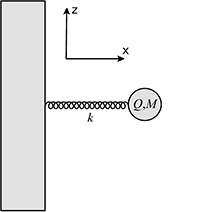Accelerated Charges Radiating Electromagnetic Waves
Problem 1
Electrons with charge \(e\) are accelerated from a negative plane electrode toward one parallel to it, at a potential \(V_0\). The mass of the electron is \(m\) and the plates are separated by a distance \(d\). Assume that the energy loss due to radiation is much smaller than \(eV_0\) and the velocity of the electron at all times is small compared to the speed of light \(c\). Calculate the energy radiated during the acceleration as a fraction of the energy with which it would strike the positive electrode in the absence of radiation.
› View/Hide Answer
The total energy radiated is:
$$ \dfrac{e^{\frac{7}{2}} V_0^{\frac{3}{2}}}{3\sqrt{2}\pi \epsilon_0 m^{\frac{3}{2}} d^2 c^3}$$
To be compared with \(eV_0\), the energy an electron would have as it strikes the positive electrode, in the absence of radiation.
Problem 2

A charged particle of mass \(M\) and charge \(+Q\) is attached to the end of an ideal spring of spring constant \(k\). The spring is constrained to lie along the \(x\)-axis and at equilibrium the particle is at the origin. The particle is displaced from equilibrium by a distance \(A\) in the \(x\) direction, and released at \(t=0\). Assume that the size of the particle is much smaller than \(A\), so it can be treated as a point charge and that the damping rate is very small. Assume also that the structure and spring have no electromagnetic interactions with the charge Q or radiated field.
- Calculate the electric field radiated by the particle along an arbitrary well defined direction in the \(x-z\) plane, at a distance R, where \(R \gg A\).
- Calculate the total time averaged power radiated by the particle.
- Assuming that the power radiated does not change appreciably as a function of time, give a simple rough estimate of the time it will take for the particle to decrease its amplitude of oscillation to \(1/e\) of its initial value. Is this assumption realistic?
› View/Hide Answers
- If \(\hat{n}\) is the unit vector pointing from the source to the observer. In the \(x-z\) plane we have \(\hat{n} = \sin\theta\hat{x} + \cos\theta \hat{z}\). The electric field is given by; \begin{align*} \left( \frac{Q A\omega_0^2}{4\pi \epsilon_0 c^2 R}\right)\cos(\omega_0 (t - R/c) ) (\cos^2\theta \hat{x} - \cos\theta\sin\theta \hat{z} ) \hspace{3mm} \text{with} \hspace{3mm} \omega_0 = \sqrt{\frac{k}{M}} \end{align*}
- $$ \langle P \rangle = \dfrac{Q^2 A^2\omega_0^4 }{12 \pi \epsilon_0 c^3} $$
- With the assumption that the power radiated does not change much over time, then the time \(t\) it would take for the original amplitude of motion to decrease to \(1/e\) of its value is \begin{align*} t \approx 0.86 \times \frac{6\pi M \epsilon_0 c^3}{Q^2 \omega_0^2} \end{align*} This assumption is not quite realistic since the power radiated by the charge is proportional to the amplitude of its motion squared and the amplitude of the motion is decreasing as energy is radiated away. This method will always underestimate the time needed for the amplitude to decrease.








